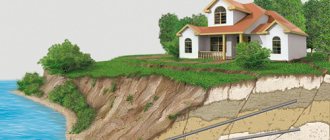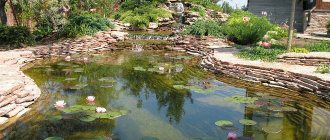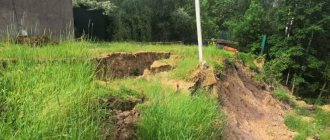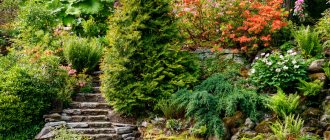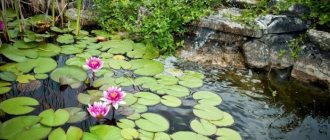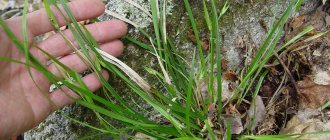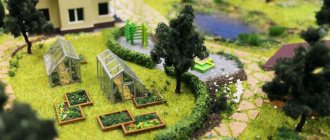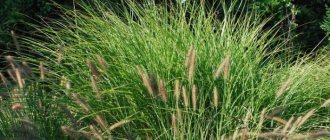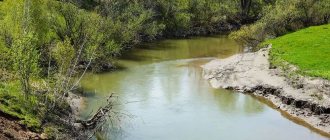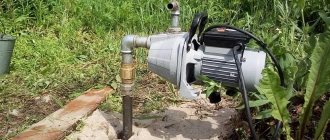Materials for strengthening steep slopes
If the shore of the pond on your property has a steep slope, then the following materials can be used for strengthening:
- retaining walls;
- wooden piles;
- gabions.
The reservoir on the site will be reliably strengthened in the shore area if retaining walls are used. Their construction is usually carried out from:
- ready-made blocks;
- stone;
- wood;
- bricks
This option can completely change the perception of the pond and significantly expand its space. The walls are strong; they resist soil subsidence and erosion. These technologies are relevant if there is a need for vertical planning of the coastline area. Quite often, the installation of retaining walls is carried out on foundations, which are piles or Renault lattice structures. When the soil is excessively mobile and loose, the height should not be less than one meter.
The pond on the site, as mentioned above, can be strengthened in the shore area with wooden piles. In practice, they are used, despite the fact that reinforced concrete products have the greatest strength. For the manufacture of wooden piles, the most durable types of wood such as larch and oak are used. The service life of such structures reaches 50 years.
If you decorate a steep bank with such trunks, it will look very effective. When using reinforced concrete piles, you can achieve high strength fencing, but such a system will look dull and gray. Before strengthening the bank, it is necessary to select a technology. One of them is the method of using These are massive blocks that are filled with stone materials such as cobblestones or pebbles. Gabions have a mesh structure, so they are resistant to groundwater and soil mobility. The service life of gabions can reach 80 years, and their strength only increases over the years.
Bank protection with different materials
Let's consider the most effective methods of bank protection today:
Anti-erosion mesh for bank protection
Anti-erosion material fills well the elements of plant soil. It has low weight, increased strength and flexibility. The roots of plants bind such material to the soil, thanks to this the plant layer is strengthened, and it turns into a reinforced area. This method is the most affordable, and you can arrange it on your own.
Strengthening river banks with coconut mats
A mesh mat of a material such as coconut is made from woven ropes that have a fibrous structure. It is able to strengthen the edges of the river and support vegetation that is planted in the water and along the shore.
Bank protection with geogrid
This method of bank protection using geogrid is an inexpensive option. Moreover, this is the most reliable method, in particular, if the coast is floating. You will get a beautiful appearance. At the same time, you will have the opportunity to comfortably and without slipping go into the water and go ashore. You can put river pebbles or other materials into the cells. You can make a mosaic that only you will have.
Reinforcing mesh for bank protection
The shore can be strengthened using a material such as reinforcing mesh with tumbled stone. You can also use other types of fillers. This mesh is very durable and will protect the surface from slopes. The net will always remain on the shore.
Using biological objects
The use of such material as a biological object of plant origin is the most capricious and troublesome method. However, it is impossible to compare it with other methods of bank protection.
Material for strengthening the banks of reservoirs
Causes of coastal deformation
Even the unpaved banks of a river, lake or artificial pond cannot resist the destructive power of water. Over time, the bottom silts up, the coastline erodes, and the reservoir itself loses its shape.
The reasons for these phenomena may be:
- soil instability, especially sandy and sandy loam;
- congestion of the coastal edge with decorative or other structures (sculptures, pumping mechanisms, bridges);
- increase in water level due to heavy rains or melting snow mass.
As a result, not only the decorative appearance of the reservoir suffers, but crops growing nearby may die and nearby buildings may become deformed. In this case, the coastline becomes a dangerous zone for humans.
Various ways to strengthen the shore
Scheme for strengthening the shore with mattresses.
- It is possible to strengthen the bank with an anti-erosion mesh. This is a cheap method, since the mesh is a fairly strong, but flexible and almost invisible material. Within a month, it is wrapped around the roots of plants and a fortified bank is obtained.
- Coconut mat for strengthening the banks. The material is natural and durable; it is a mesh of thin intertwined ropes that will support the shore for several years.
- Geogrid for strengthening banks. Inexpensive, but the most effective option. The geogrid can be laid even on an already creeping bank; it will serve you for many years, and the bank will take on a beautiful appearance. You can easily move along it even on steep slopes, because it has a cellular texture, so it does not slip.
- Strengthening the bank with reinforcing mesh. Also a good option, the mesh will prevent slopes from forming.
- Biological objects that strengthen the banks. A rather expensive and short-lived method, because to strengthen the bank you will only need natural elements.
- Strengthening the shore with piles. A reliable method in which the shore is strengthened by driving in support piles made of metal or concrete, less often plastic. Ideal if there are steep cliffs on the shore.
- Sheet piling bank protection is the cheapest and fastest method. The sheet pile is laid along the coastline and prevents water from washing away the ground behind it.
- Plants protecting the shore. A very costly, difficult process, the results of which you will see after a few years. Trees with their roots will create a protective frame that holds the soil.
- Strengthening the bank with larch. The most reliable and durable method, due to the fact that the tree is quite unpretentious and durable.
- Strengthening the shore with gabions. Flexible, lightweight design that can be used to give the shore any look.
We have looked at the main methods and materials for strengthening the shore; now let’s move on to how to make such a strengthening with your own hands.
We strengthen the bank of the pit
Published: September 10, 2017
Strengthening the bank of a pond at the dacha
PsFB - material for strengthening the banks of reservoirs
Strengthening the banks of rivers and streams
Strengthening the banks of a river or stream is carried out according to almost the same principles as the bank protection of lakes and reservoirs. It is necessary to take into account the angle of inclination, degree of destruction, hydraulic conditions and other factors. For example, strengthening the banks of a river or stream in a suburban area can be done using piles made of oak, larch or aspen, but for long rivers with intense flow this method is considered very expensive. For garden ponds, you can buy nets, slabs, mats or geotextiles with grass seeds, although doing bank protection with your own hands is not recommended. Firstly, each technology has its own subtleties that only professionals know. Secondly, before strengthening the banks of a river or stream, a project is developed, all stages of work are determined and the amount of materials is calculated. And thirdly, strengthening the banks of lakes, rivers or streams is also work to restore the landscape. Look at the photos of the bank protection that we carried out and make sure that the use of slabs and nets did not in any way affect the overall picture of the summer cottage.
Coastal strengthening.
Do-it-yourself shore strengthening
Very often on forums on the Internet the question is asked: “How to strengthen the shore of a pond with your own hands?” There are many recommendations, including making your own geogrids and other materials used for bank protection. However, the opinion of our company’s specialists is unequivocal: strengthening the banks with your own hands can only be done for small country ponds with gentle slopes. This, for example, is planting plants and trees or lining the shore of a pond with boulders, which also allows them to maintain their shape. If you have certain skills, strengthening the banks with your own hands can be done using wooden piles, which are driven around the entire perimeter, forming a palisade. But even in this case, it is very difficult for a non-professional to complete such work quickly, competently and accurately. The same can be said about strengthening the banks with gratings or mats: if you are not familiar with the technology of bank protection, then it is better to initially turn to specialists and entrust this work to them.
Strengthening banks with aspen
When it comes to strengthening the banks with aspen, oak or larch, it does not mean planting these trees, but using piles. Of course, planting vegetation is also one of the methods of bank protection, but in this case, alder, poplar, ash or willow with a developed root system are planted from trees, and sedge, iris, loosestrife, mint, etc. are planted from plants. Most often, strengthening the banks of a pond is carried out using piles made of oak and larch, the wood of which has high strength and unique moisture resistance. Strengthening the banks with aspen is considered an alternative option, primarily in terms of price, since larch and oak are quite expensive materials. Aspen wood also has excellent performance characteristics, but is cheaper. It is almost as strong as oak, so strengthening the banks with aspen will no less effectively prevent the problem of bank erosion. Aspen has high moisture resistance, because it is no coincidence that it is used to build wells and baths. Accordingly, from this point of view, strengthening the banks with aspen is considered completely justified.
Cost of shore strengthening
Stage 4. Digging a pit
Step 1. First, we create a scale sketch of the future reservoir, indicating the size and width of the curtains (shelves for plants, that is, the upper stage of the structure). This will help avoid possible difficulties not only during construction, but also when planting.
We also think about the accent of the composition - a large original stone, for example, a sculpture or just a tree.
Step 2. Using a rope or sand, we outline the expected contour of the reservoir. We make sure to check that all the banks are at the same level, and then use a shovel to cut the turf along the perimeter of the pond.
Making the markings Making the markings
Step 3. Now let's start the excavation work. First, we dig a pit to the depth of the first level (about 30-40 cm) and mark a line from which we will dig down to the second level (90 cm). Next, we create the deepest level (up to 1.8 meters, if we plan to breed fish), and extract the last portion of soil.
The pit for the pond is formed by characteristic ledges - curtains for planting plants
Step 4. To dig a reservoir, it is advisable to use the services of specialists in this kind of work, accompanied by a small excavator, because this work is quite difficult. But if you decided to do this stage of the work yourself, then you should be prepared for the fact that moisture will accumulate in the pit and you will have to dig in dirty slurry. To remove water, you can use a pump (but only one specifically designed for pumping liquid with solid particles). You can dig another hole nearby to dump water into.
Digging a multi-level artificial pond
Step 5. Carefully inspect the bottom of the finished pit for branches, sharp stones and anything that could damage the film. We check the horizontality of the banks and, if necessary, level them.
We carefully inspect the bottom
Step 6. We dig a ditch 20 cm deep along the perimeter of the pond to fix the film. Then, using a rope, we measure the dimensions to determine the required size of the film, add 0.5 m on each side.
When carrying out excavation work, you may encounter the problem of where to put the earth from the hole. An excellent solution to this problem is to raise the level of the site by evenly distributing the soil over the entire area of the garden. Another option is possible - to use the land to build an alpine slide.
Strengthening technology
Wooden piles made of larch, oak, pine, and acacia have been used in the design of a steep bank since ancient times. These rocks are characterized by high strength. The service life of a structure made from such wood is almost half a century. Experts prefer to use East Siberian larch.
Did you know? The pile structures of Venice, a city on the water, are made of larch. This fact was documented in the work of the Italian historian Tentori back in the 17th century.
Wood of this species can serve for a longer time due to its increased resistance to soaking and rotting processes - it only becomes stronger over time. The structure of larch logs is elastic, hard, twice as dense as pine, and contains a large amount of resins. It is these natural properties that provide protection from an aggressive environment. The material is more expensive compared to common types of wood, but the costs are well justified due to its advantages.
Strengthening the shoreline prevents the pond from becoming overgrown with reeds. Larch logs, when in water, withstand even the most severe frosts and do not require additional care during the operational period. The ecosystem of the reservoir remains intact.
Did you know? Larch is a long-lived tree. It can reach a height of 50 m with a trunk diameter of up to 1 m. Even nine-hundred-year-old specimens are known.
Larch logs are heavy. The technology for strengthening the slope of a pond involves immersing the trunks in the soil to a depth of 0.5 to 2.5 m (this indicator is influenced by the installation method, type of soil and size of the reservoir).
For this purpose, on large objects:
- wash away clay and sand with a water jet;
- they use drilling holes to hammer in logs;
- The beams are immersed with a vibrating hammer.
Manual installation of trunks is different: specialists change the position of the logs, adjusting them perfectly to form a row. Then the beams are fixed, resulting in the formation of a strong wall. Bank protection does not damage the landscape composition, but this work requires a lot of time and effort. Self-installation of beams will take about a month for the owner of a small pond and his assistants. Experienced craftsmen carry out similar work much faster - within 5-7 days.
The technology for strengthening the bank with oak or pine piles is no different from the use of larch, with the exception of the durability of the structure. Additional treatment of wood with moisture-repellent impregnation is ineffective: over time, the material is damaged as a result of contact with water and pest invasion.
You can use larch shields to strengthen the slopes of the pond. They are made by knocking down boards into a single structure and mounting them on piles. The cost of such shields is 25% cheaper than using beams. The work should be based on accurate calculations of soil pressure, taking into account the characteristics of the reservoir. Self-strengthening the shore of a pond with the help of shields is carried out strictly following the technology, otherwise the structure may become warped, the earth will squeeze out the lining and you will have to do everything all over again.
Protection of a concrete pond
In order for an artificially made pond to serve as long as possible, you need to approach its strengthening in a comprehensive manner. Protection of a reservoir can be:
- technical - involves the use of artificial resources such as geogrids, gabions, and so on;
- biological - planting the area with plants that slow down erosion, for example, larch, reeds and others.
Special materials give the desired effect immediately after installation. The plants take time to develop roots, but they look more natural.
To strengthen a concrete reservoir, the following is suitable:
- The special mesh is lightweight, durable and flexible. The geomat is filled with plant soil components, the roots strengthen the soil. This results in a reinforced zone.
- Geogrid is a method identical to the previous one. Pebbles are used as the main material.
- Coconut mat - is formed from intertwined cords with a fibrous structure.
- Gabions are box-type retaining walls, used when previous options are ineffective. In addition to reliability, they perfectly complement the design of the site.
The above methods are quite effective and last much longer than green spaces. If desired, you can decorate the materials, carefully hiding their gray construction appearance.
Bank protection and materials used:
Strengthening the banks with gabions (Reno mattresses)
Reno mattresses are flat gabion structures made from double-torsion metal mesh with a zinc or polymer coating. To ensure rigidity, the structure is divided into sections using internal diaphragms. At the construction site, the sections are filled with natural stones, creating a monolithic structure.
The main characteristics of Reno mattresses are strength, permeability, versatility in use, and environmental friendliness. It must be said that the high strength and stability of such a structure only increases over the years - thanks to the germination of vegetation in it. Plants make the structure less noticeable over time, allowing it to look as natural as possible. The lattice structure of Reno mattresses makes them permeable to water and air. Thanks to its coating, the structure is not afraid of exposure to aggressive environments and is not susceptible to rotting. Its integrity has been maintained for more than 25 years of operation.
Reno mattresses are used as area coverings to protect coastal slopes and slopes from erosion processes, as well as as bases for retaining walls made of box-shaped gabions. Reno mattresses are effective for bank protection of a reservoir, protecting the bottom from erosion, in spillway structures, and for lining spillway dams and dams.
The flexible design of the mattresses allows you to give them the desired shape. Important properties of Reno mattresses are their compatibility with other materials, ease of installation and cost-effectiveness.
Strengthening the banks with geogrid
Bank protection of a river, canal or any other body of water, fixation of high slopes can be done by installing a geogrid. This mesh structure made of hard plastic has sufficient elasticity and resilience to compensate for the settlement of soft soil along river banks. The flexibility and plasticity of the structure allows for the strengthening of coastlines with complex bends. Other advantages of geogrid: resistance to external influences (moisture, ultraviolet radiation and aggressive environments), durability, environmental friendliness, ease of transportation and installation. The ability to combine geogrids with many facing materials allows not only to strengthen the banks of a pond or river, but also to achieve high aesthetic characteristics of such a project.
Information on the topic:
- Construction of ponds.
- Bank protection using gabions.
- Laying geogrid.
You can purchase the necessary materials, find out the cost of installation services and delivery conditions from our managers or by calling one phone number
Add comments
Hide form
How to strengthen the banks of a pond at your dacha with your own hands
An artificial reservoir pleasantly diversifies the landscape, but if mistakes were made during construction, the banks will begin to crumble after a while. The soil “slides”, the pond silts up, the film that lines the pond or an unsightly concrete base is visible along the edges. It is better to immediately strengthen the banks of the pond at the dacha in order to decorate them without fear of erosion. When choosing a method, you need to take into account the size of the reservoir, features of use and your financial capabilities.
The most popular methods for doing the work yourself
The most well-known technical methods for protecting a reservoir from collapse are gabions and geogrids. Both methods are based on the use of a mesh structure, which protects the walls and banks of the reservoir from crumbling.
Features of geogrid installation
To strengthen the pond with your own hands in this simple way, you will need:
- geogrid with suitable cell size;
- geotextiles for drainage;
- anchors for fastening and pneumatic stapler;
- shovel;
- filler.
The top layer of soil is removed, drainage is laid, and a geogrid is placed on it. The individual sections are fastened together. The cells are filled with crushed stone, frost-resistant concrete, soil or other material. If plants are planted in the soil filling the cells, their roots will additionally strengthen the bank.
The choice of filler for mesh cells is a matter of taste
Gabion structures for decoration and strengthening
Gabions are one of the most reliable methods for strengthening banks and walls. Boxes made of wire, fastened to each other, are installed along the edge of the reservoir. The corners are fixed. Using gabions, you can build retaining structures along the shore.
Densely filled with crushed stone larger than the openings of the cells, gabions serve not only to strengthen, but also to decorate the reservoir. The porous structure eliminates the need for additional drainage. Over time, this structure becomes even stronger due to filling with soil and the growth of plants.
Gabion structures for bank decoration
Biomats and plants – caring for the environment
How to strengthen a pond at the dacha so as not to disturb the existing landscape and give the pond a natural charm? The most environmentally friendly method is to strengthen the shore of the pond using the root system of plants planted along the coastal zone. However, it is quite difficult to independently select specimens that will prevent shedding. It will take time for the plantings to grow, but there is a risk that they will not take root. Suitable for the middle band:
- weeping willow;
- sea buckthorn;
- Red Ribes;
- sedge;
- marsh iris;
- cattail and other species;
Plants help make a pond a natural part of the landscape
With the help of coconut mats, the strengthening of a pond in a dacha is carried out even with very steep slopes (up to 60%). The slope is leveled, and natural fiber mats are laid on it with an overlap of 20 cm. They are attached to the pond film with waterproof mounting adhesive. Then a thin layer of soil is poured and the lawn is sown.
Large stones and boulders look very attractive, which can be used to lay out a fence near the water after installing a geogrid or biomat.
Decorating a steep bank with piles
Piles are the oldest method of strengthening reservoirs. Traditionally, piles were made of wood, but strengthening the shore of a pond with your own hands using wood is not as simple as it seems at first glance. Hardwood piles look impressive, but driving them requires special equipment. Another “minus” is that over time the wood may darken. Special impregnations help, but are not a panacea.
Wooden piles to strengthen the bank
PVC piles are a modern alternative to wood; they will last for decades, but their installation also requires special equipment. For a small reservoir, using the pile method is not very convenient.
The pond will retain its original appearance for a long time if you think about strengthening it at the pit stage. To do this, the work must be supervised by a professional who will assess the steepness of the slope, the size of the reservoir, the characteristics of the soil and advise which type of reinforcement to choose.
After consulting with specialists, you will learn how to strengthen a pond at your dacha with your own hands or, having assessed your strengths, you will be able to order all the work on a turnkey basis.
Coastline fortifications
When choosing a method for strengthening the shore of an existing or future reservoir, you should take into account how flat it is, what type of soil is in this area, whether there is a current, and how great the danger of erosion is.
Let's start with one of the most reliable ways to strengthen the coastline - the use of gabions.
Regarding artificial ponds in the country, their walls can initially be completely built using gabions. And the pond will turn out to be very durable, beautiful, with smooth, strong banks. If the shore of the reservoir is flat, then we will talk about Reno mattresses, flat gabions that are laid horizontally on the ground.
Video about Reno mattresses:
The second reliable and time-tested option for strengthening the coastline is the use of geogrid. First, part of the soil is removed from the shore, the surface is leveled, and geotextiles are laid. Then the geogrid itself is secured with plastic or metal anchors.
Stone, crushed stone, soil, sand are poured into the cells - at your discretion. If the geogrid is covered with earth, it is quite possible to plant plants on top, which will make the area more beautiful. In addition, the roots will additionally keep the banks from sliding into the pond.
The third most reliable way to strengthen the coastline is to use PVC sheet piles. It is made from composite materials and polyvinyl chloride. Perfectly suited for steep banks. By the way, PVC sheet piling is also used to create terraces and supporting walls in sloped areas. The material can be reused.
As a result, a reliable coastline is built from PVC sheet piling, and you can choose the color of the material. Each sheet pile has a rib protrusion that provides traction to adjacent pieces. The downside is that in dense soil, if the bank is high, the sheet pile will have to be driven using hydraulic equipment. Or put in a lot of effort.
Quite reliable, but still more decorative options for strengthening coastlines include the use of wooden piles, logs and boulders. Yes, it is beautiful - wood and stones of different sizes on the shore. Moreover, very often such strengthening turns out to be complex - a small mound of stones supporting a wall of wooden piles. This will make it more reliable.
Stones can be selected in a variety of shapes and sizes and laid out on the shore in a beautiful composition. But, let’s face it, both options are not for large bodies of water; most often they are used on the banks of artificial ponds.
Important! Not every type of wood can withstand constant exposure to moisture. Larch, for example, can, but it is expensive. Therefore, we recommend protecting wooden piles with water-repellent impregnation.
Therefore, we recommend protecting wooden piles with water-repellent impregnation.
The fifth option for strengthening coastlines is the most environmentally friendly, beautiful, but not always suitable and reliable. This method involves planting plants. Most often, willow trees are planted to strengthen coastlines; shrubs - amorpha, bladderwort, sea buckthorn, red currant; as well as macrophytes - marsh iris, calamus, sedge, cattail, manna, rush. Macrophytes thrive partially in water and are not afraid of flooding.
It is important that the plants have an extensive root system, which will keep the soil from sliding into the water. Plants can be combined with boulders - partially fill the bank with stones, and plant some with plants. Also environmentally friendly, an additional way to strengthen the banks is to use linen or coconut mats
They are covered with soil and plants are planted on top.
Also environmentally friendly, an additional way to strengthen the banks is to use linen or coconut mats. They are covered with soil and plants are planted on top.
To carry out large-scale work to strengthen the banks of a natural lake or river, professionals are usually brought in. But you will have to deal with your artificial pond yourself. Or hire workers. The price will vary depending on the task, volume of work, complexity and materials used. published econet.ru
If you have any questions on this topic, ask them to the experts and readers of our project here.
Capital bank protection
Capital bank protection can reduce to a minimum the likelihood of damage to the coastline from the destructive effects of water. This group of bank protection works includes technologies based on the use of gabions, geomats, sheet piles, hydraulic grades of concrete, and special volumetric reinforced concrete structures.
Gabions are meshes made of galvanized double-twisted wire, which at the installation site are laid out in boxes filled manually with large natural stones. To securely fasten individual structures to the ground, special anchors are used. The boxes are twisted together with wire. After the gabion is partially filled with stone backfill, so-called “braces” are installed, which prevent the opposite walls of the box from “diverging” to the sides.
The banks of reservoirs, reinforced with gabion structures, do not erode or float. For many years, the contour of the coastline specified during bank protection works is preserved. This technology, long used in Europe, has found application in Russia. You can see gabion structures on ponds, rivers, bypass canals and other bodies of water.
The river bankline is neatly decorated with gabion structures that have a strict geometric shape. Natural stone, located in mesh boxes, harmonizes perfectly with the autumn forest
Sheet piles made from PVC and composite materials allow you to strengthen the coastline in the shortest possible time. This method of bank protection is considered low-budget. PVC sheet piling is most suitable for arranging steep banks. One of the advantages of this material is the possibility of its reuse. During installation, individual sheet piles are lined up into a continuous, dense wall. Reliable connection of adjacent elements is ensured by a longitudinal rib protrusion located on each sheet pile. Driving of single or paired PVC sheet piles is carried out using autonomous hydraulic equipment, selected taking into account ground conditions.
Schematic representation of the installation of sheet piles made of PVC materials, allowing to strengthen the steep bank of an artificial or natural reservoir
Briefly about the main thing
When the need arises to shore up shorelines, several engineering techniques come to the rescue. Classical methods (gabions, piles) have been used for centuries, modern ones (geogrid, sheet piling) have appeared thanks to the development of technology.
To choose the appropriate method, they are guided by the shape of the coast and the size of the reservoir; it is also important how quickly the erosion progresses (how quickly results are needed). For private plots, both the reliability and durability of the structure and its aesthetic component are important.
Ratings 0
How to strengthen the edges of a natural pond in a summer cottage? — answers from 7dach.ru experts
For a long time I dreamed of a pond in the yard, and now my dream has come true. The joy knew no bounds!!! But there was a problem with water purification. The water quickly disappears and disappointment sets in, which I never expected. Nymphs grow in my pond, and...
The water surface glistens, dragonflies flutter, water lilies and lilies delight the eye - beauty, and that’s all! Water in a garden plot is needed not only for irrigation - it is one of the axioms of landscape design. Simple small ponds, elegant garden fountains or...
Creating even a small reservoir on your site may at first seem like a rather difficult task. Of course, this is not easy, especially when it comes to large reservoirs made of stone, cement, multi-level, with fountains, etc. Everything also depends on...
For a long time, a terrace with a pond was just a secret dream for Barbara and Rüdiger Elger. But finally the couple decided to bring their idea to life. Now goldfish live in their pond... 1. Pit for the wife’s future pond...
There is mud in my dacha pond. How to get rid of it?
I decided to take part in the competition of country master classes. Maybe my little experience will be useful to someone! I am, of course, not a professional, but now, thanks to the Internet, you can learn a lot, if you have the desire! I didn’t have this desire...
Features and varieties
Larch is a tree that belongs to the class Conifers, division of Gymnosperms. One of the most popular and widespread varieties of larch is the weeping larch. This plant is often used to decorate areas in landscape design. The main advantage of using the plant in landscape design is the fact that the plant creates virtually no shadow, so low-growing flowers can be planted at its base.
A distinctive characteristic of the weeping larch on a trunk is its unusual hanging crown. In order for the tree to fully fulfill its decorative role, its crown is shaped by pruning and shearing. In addition, for these purposes, another mandatory procedure is carried out to graft the tree. If you act according to the instructions and advice of botanical scientists, as well as experienced gardeners, then in the end you will get a healthy, beautiful and strong tree with a straight trunk and branches growing vertically downwards.
The height of the plant can vary significantly depending on the specific variety, place of growth, as well as care measures. Thus, weeping larch can reach from 1 to 8 meters. The tree grows quite slowly - in a year it can add no more than 20 centimeters in crown volume and 30 centimeters in height.
During the spring period of development, bunches of needles may appear on larch. The needles of the tree are quite soft to the touch, and they themselves can be painted in a wide variety of shades of green and light green. The shoots of the plant are very thin and heterogeneous in structure, and a large number of different tubercles, processes and other irregularities can be located on them. After the weeping larch has finally matured, it begins to form cones, which are divided into male and female.
They differ not only in internal structure and organic features, but also in appearance. Thus, it is female cones that are considered more aesthetically attractive. Their color is dominated by bright and rich shades, and they themselves resemble a pink inflorescence (bud or blossoming flower).
Today, scientists count several species of larch. Let's consider the most popular and beautiful of them, namely:
- Repens - this variety is characterized by unusual branches that spread along the ground;
- “Bullets” - this species forms light green shoots that reach the surface of the ground;
- “Kornik” - the height of the plant is quite small, larch is distinguished by an incredibly beautiful crown, which has a spherical shape and is painted in a rich emerald shade;
- “Krejci” - the variety differs from all others in its miniature size (up to 1 meter in height) and a fluffy crown of irregular shape;
- "Grey Pearl" has a dense, rounded crown and is characterized by a very slow growth process;
- “Blue Dwarf” - the shoots of the tree have a versatile focus.
- “Bambino” - this variety is distinguished by the smallest dimensions among all the varieties described above, and also has needles, the color of which varies between blue and green;
- Wolterdingen – the maximum height of larch is about 0.5 meters.
What it is
Bank protection is a set of special measures that are aimed at protecting the shore of an artificial or natural water source. People who own houses, cottages or other structures near a reservoir are thinking about how to strengthen the territory and prevent negative consequences from the influence of water. Strengthening with hydraulic structures is necessary to protect the coastal line from erosion, collapse, washout, washout from flood or storm water, and ground subsidence.
The erosion and subsidence of the shore is one of the reasons for the shallowing and overgrowing of not only the water source itself, but the area around it. Structures erected in this zone are in danger of destruction, so currently there are measures that protect the coastline and prevent all negative consequences.
Achieved effects
Reinforcement of the bank in a country house, a plot of a country house or in a park area allows you to maintain a stable line geometry for a long period. Thanks to this, the following goals are achieved:
- prevention of destruction and damage to structures and structures located in the coastal zone;
- prevention of flooding of the territory;
- preventing shallowing of the reservoir;
- formation of neat, aesthetic, geometrically adjusted slopes.
Thus, the bank protection work carried out by our specialists is an important stage in measures to create an aesthetic landscape on the site and preserve it.
Strengthening river banks with plants
The riverbank can also be strengthened using plants for this. They must have a fairly strong branched root system that will be resistant to flooding. This method is acceptable only in cases where the river flow speed is no more than 1 m per second, while the waves do not exceed 0.3 m. The river bank can be strengthened with plants, herbaceous flora and shrubs, among them:
- amorphous;
- marsh iris;
- manna;
- sea buckthorn;
Aquatic vegetation is planted in the underwater zone; in this case, aquatic iris can be used. As soon as the planting has been carried out, the sod should be carried out.
Eco-fixation
You can strengthen the soil along the edges of the reservoir using environmentally friendly methods. For example, plant plants that reinforce the ground with their roots. Selecting plants with the appropriate root system is not easy. In addition, it takes time to wait until they grow and entwine their roots around the banks. There is a risk that the plantings will not take root. If you still decide to cope with the task in this particular way, pay attention to the following plant options:
- cattail;
- willow;
- Red Ribes;
- sea buckthorn;
- marsh iris;
- sedge.
Coconut mats can be lined with stones or plants can be planted on them to hold the soil.
Another eco-friendly way to strengthen the banks is coconut mats. With their help, the walls of the reservoir will look smoother and more aesthetically pleasing. This method is suitable even for the steepest slopes, but the slopes must first be leveled. The mats are laid overlapping, covering at least 20cm of the adjacent one, and they are attached to the pond waterproofing film with mounting adhesive. Then you can do this: line the edges of the pond with stones, or pour a layer of soil and plant plants.
Making a pond with a bowl yourself
When constructing a pond on your own at your summer cottage, you can use available items. This will help you find a use for an old bathtub, rubber tires and other materials.
From an old bathroom
Due to its strength and large volume, a cast iron bath is suitable for arranging a pond. The construction instructions include the following steps:
- The area is marked taking into account the dimensions of the bathtub, adding 10 cm on each side, after which a pit is dug. Its depth should be 20 cm greater than that of the container.
- At the location of the drain hole, an additional hole is made 50 cm deep and 30 cm wide.
- A sheet of steel rolled into a cylinder is inserted into the second pit and filled with gravel or crushed stone. This is necessary for arranging drainage drainage.
- Layers of crushed stone and sand are poured onto the bottom of the main pit, the base is compacted and the steel sheet is pulled out.
- A bathtub is placed inside the pit so that the upper edges are at ground level. The drain hole should be located above the drain.
From a tire or other improvised means
A pond from a tire and alternative materials is made by analogy with the previous method. The difference lies only in the shape and dimensions of the artificial reservoir.
Variety of options for shore strengthening
Before starting work, it is necessary to decide on the strengthening option and the materials used.
The following types and methods are distinguished:
- Reinforcement with anti-erosion mesh. This material has high strength, flexibility and low weight. With the help of the roots of planted plants, the geomat is firmly bonded to the soil, forming a continuous reinforced fabric.
- Using a coconut mat, which consists of fibers of different densities woven together. This fabric is used to strengthen the shore of a pond, reservoir or river.
- Use of geogrid. This method is simple and highly decorative. In addition, the descent to the water will be convenient, and the grid cells can be filled with any decorative filling that will add individuality to your pond.
- Use of reinforcing mesh and tumbled stone.
- Use of gabions. A fairly simple method, represented by the construction of retaining walls in the form of boxes with stones. It is used in many cases, and sometimes it is simply irreplaceable when strengthening a sliding bank.
- Strengthening with plants (trees and shrubs). Eco-friendly, aesthetic, but at the same time the most expensive and complex method, because it requires good knowledge about the necessary plants, which are selected in accordance with environmental conditions and soil characteristics. Therefore, this option is often not rational.
- The use of materials such as larch, oak, etc. This is an old and long-known method of bank protection, which is suitable for steep banks. It looks very original and beautiful, and the special properties of larch will allow the structure to last for many years.
- Use of piles (metal, plastic or concrete). This is a fairly new option that is suitable for steep bank slopes. Similar to the previous one in its execution.
It is best to carry out soil strengthening at the stage of digging a pit, when you want to create an artificial reservoir.
Larch reinforcement
When to use
It’s nice that the arrangement of the shore of a pond at a dacha can be done in different ways, but the choice of the appropriate method mainly depends on the nature of the coastline. The following solutions are practical:
- If the coast is flat. The best results will be shown by a volumetric geogrid, as well as its varieties: geomats, geogrids.
- If the natural appearance of a reservoir is important, a combined method is used: biomats (or other engineering methods) with the addition of plants planted in the coastal zone.
Sheet pile wall in combination with decking Source prom.st
- If the coast is steep. The best option is gabions, as they are economical, easy to install, reliable and aesthetic designs. Sheet piling and conventional piles are also suitable; if wood is used, then it is better to take larch. In European countries (as well as in China and the USA), preference is given to PVC sheet piles or concrete piles.
Like many other construction works, it is best to strengthen the banks of the pond in the warm season (ideally from May to September). If you carry out work in winter, then after the soil thaws, heavy parts of the structure may shift, and everything will have to start again. If signs of erosion appear on the shore (washed out roots, crumbling soil), and the time for work is not suitable, you can create temporary reinforcement using old car tires or any stones.
The combination of concrete slabs and pebbles looks quite natural Source pinimg.com
How to strengthen the shore of a reservoir with your own hands
If your house or land is located near the shore of a natural reservoir, or you have an artificial reservoir created on your site, you need to think about strengthening the bank. Water has great destructive power and, if this is not done, the shore will gradually be washed away and destroyed. It is better to carry out bank management of an artificial reservoir during the development of a pit or in the process of forming a bowl.
Strengthening the banks of natural reservoirs is carried out at the moment of maximum decline in water levels - at the end of summer or autumn. Measures taken in advance will prevent destructive processes and will save your finances.
This method allows you to strengthen the banks and at the same time leave the reservoir in its natural beauty. It can be used at water flow speeds of no more than 1m/s.
Special plants that grow in nature on the banks of rivers and lakes are planted. Among the trees, these are black poplar or weeping willow, and among the shrubs, sea buckthorn, red currant, and bladderwort. Be sure to use sedge, reeds, marsh iris, cattails and other plants whose natural habitat is near water. The coastal soil is completely covered with biomats made from natural fibers or ready-made turf. This method of strengthening the shore is considered the most expensive of all.
Use of natural stone
If the banks of the reservoir have a slope of no more than 20˚, then the shore can be strengthened with pebbles and boulders of various sizes. Such strengthening will give your shore a beautiful and unique appearance. The stones are laid on a supporting base - geogrid or geotectile, this prevents the stones from sinking into the silt or the shore from sliding.
It's hard, painstaking work, but the results are worth it. The coastline looks natural and is well preserved.
Strengthening the banks with wooden piles
Another method of decorative beautification of the banks can be done using wooden piles. This method is used if the soil around the reservoir is not mobile or loose. For the manufacture of piles, only hard wood species are used - larch, oak or acacia.
This method can be used on the steepest banks. Installation is carried out using special equipment or manually. This strengthening looks most harmonious next to buildings made of natural wood.
Use of gabions
Carrying out work using gabions is one of the methods of capital bank protection. Gabions are made of galvanized mesh and filled with natural stone during installation. Filled gabions are attached to the soil with anchors, and they are also connected to each other into a solid structure. This method of shore strengthening is widely used in Europe and guarantees that the coastline will remain clear for many decades.
In addition, such a shore looks quite natural and harmonizes perfectly with buildings lined with natural stone.
Strengthening the bank using PVC sheet piles
This method of capital bank protection is considered the fastest to construct and the most economical. It is used on steep and steep banks. Sheet piles are connected into a single protective wall during installation. Their installation is carried out using special hydraulic equipment. The piles are securely fastened together by longitudinal ribs.
Capital methods of strengthening the banks reduce to a minimum the likelihood of their destruction for many years.
If you find an error, please select a piece of text and press Ctrl+Enter.
Decorative bank protection
The second group of materials used in bank protection measures includes natural stone and wooden piles. These natural materials can not only protect the banks of reservoirs from erosion processes, but also give them aesthetic appeal.
Method #1 - wooden piles
Hard wood is used as the starting material for the manufacture of log piles. Most often, larch or oak is chosen for these purposes. Greater preference is given to East Siberian larch, which, while in water, can retain its properties for half a century. The steep bank, framed by sanded larch trunks, carefully selected in diameter, looks very impressive. Especially if there is a structure built from rounded logs near the water surface. Concrete fortifications, of course, are inferior to wooden piles, as they look gray and dull. However, over time, the wood may darken, which will worsen the decorative qualities of the bank protection structure. The rate at which logs darken depends on the amount of organic matter in the water. When choosing a tree species, you should take into account the climatic characteristics of the region.
Recent Entries
Lilac perennials that are beautiful, compact and do not crowd out other plants Why when buying seedlings you should not take the sellers’ word for it and how to determine the age of the plant using 3 signs Tomato seedlings have turned purple or whitish: why the color has changed and how to save the plants
Installation of wooden piles can be carried out from the shore using special equipment or a simple manual method. Modern models of dredgers allow you to install wooden piles from the side of the reservoir. Strengthening the banks of reservoirs with logs is not advisable on moving and loose soils.
A neat row of larch logs emphasizes the beauty of the shore of the reservoir, preventing its deformation under the influence of the destructive force of water. Strengthening the bank with wooden piles ensures a safe approach to the reservoir
Method #2 – natural stone
Filling the coastline with natural stones of various sizes is used on long, flat banks. The slope angle of the bank should not exceed 20 degrees. If there are access roads, vehicles are used to transport boulders or pebbles. In hard-to-reach places, work is carried out manually. Before laying the stone, it is mandatory to prepare the shore surface. If you neglect this stage, the stones will simply drown in soil saturated with water. To prevent this from happening, it is necessary to lay a load-bearing base on the coastal zone being strengthened, which can be used as a material such as geotextile, geogrid or geogrid.
The gently sloping shore of the reservoir is strengthened with a three-dimensional geogrid, the cells of which are filled with fine-grained crushed stone. The walls of the cells prevent the crushed stone from sliding into the bed of the reservoir
Construction of a stone castle during the construction of the shoreline of an artificial decorative reservoir. The painstaking work of laying boulders is done by hand by masons
A more labor-intensive method is considered to be strengthening the shoreline of a reservoir using a “stone castle”. In the language of professional masons, this term is usually used to describe the dense laying of boulders (stones whose diameter exceeds 10 cm). For each boulder, a placement location is selected, taking into account its shape and color. In this case, large stones are carried by a master mason manually. During a shift, a professional in his field is able to drag several tons of boulders. This method of bank protection involves a lot of physical effort, but in the end it turns out not only to strengthen the shore line of the reservoir, but also to give it a special, unique look.
Additional events
To do this, you will need to purchase seeds of perennial grasses or small trees and simply sow as densely as possible on the top of the bank and, if possible, on steep slopes.
The second stage will be decorating the shore. If the shore is sandy, then you can simply bury the visible parts of the coconut mat, and if it is grassy, then you can add more stones or earth - this will create additional strength and ensure the beauty of the entire shore.
There are many advantages of using coconut mat, here are the main ones:
- The material is environmentally friendly, because it consists exclusively of natural elements.
- Cheapness is one of the main parameters if you need to cover large areas.
- The installation work is very simple, even one person can handle it within a few hours.
- For several years the slope will not erode or slide.
- The mesh structure allows plant roots to pass through it, which will provide additional strength.
- The strength of the material is not lost from sunlight, contact with water and from the decomposition of natural organic matter.
As you can see, your problem with landslides from constant contact with water can be solved very quickly with the help of your hands, because no additional knowledge is required. In addition, there will be no need to spend a lot of money or obtain permits from government authorities.
https://youtube.com/watch?v=dm0GWyw5OuA
By spending only a couple of hours of your time, you will forget about the problem for 2-3 years, or maybe more, because if there is a lot of vegetation on the shore, it will create tangles of roots and its own mesh, which will continue to hold the shore after the decomposition of the coconut mat. Also, after a couple of weeks, no one will be able to guess that the bank is reinforced, because the material will no longer be noticeable.
Strengthening the film base
If the bottom of the reservoir is insulated with a special layer, a decorative film can serve as the shoreline. We recommend choosing options with gravel spraying. The material does a great job of hiding the synthetic origin of the components. The film is installed on top of the waterproofing layer. The edges are attached to the base with glue for water works.
The work process ends with decorative processing. Stones of different shapes and sizes are installed along the edge of the pond. The composition looks great like a natural landscape. To do this, you only need a few stones and a little imagination.
To strengthen you will need stones
Important Factors
When organizing bank strengthening, many factors should be taken into account. This will help you achieve good results.
Soil characteristics
First of all, it is worth familiarizing yourself with the key properties of the soil. There are types of soil that tend to crumble.
Coastline Features
Equally important is the assessment of the features of the pond shore
In this case, it is worth taking into account its height and steepness of the slope.
How is the problem area located?
It is definitely worth determining the location of the pond. Taking this into account, a method of strengthening is chosen
When carrying out work, it is important not to disturb the appearance of the site
It is worth considering the purpose of the territory. The location of nearby residential buildings and other structures matters.
Climatic features
The climatic features of the area are of great importance. These include sharp fluctuations in temperature and precipitation.
Piles for bank protection
Piles can also be used for bank protection. They can be either metal, concrete or plastic. Strengthening the banks using metal or concrete piles. Plastic material can be used. This method is often used for very steep banks. The method of laying is somewhat similar to strengthening the banks using larch and screw methods. Concrete and plastic are new materials that have proven themselves in operation.
Plants for bank protection
This method is the most labor-intensive and expensive, but, in addition, it is the safest and most beautiful in appearance. Vegetation for bank protection is selected taking into account the properties of the soil in this area and based on the goals set for the formation of strong barriers of several stages against shoreline erosion. Due to the lightness of the soil and the heterogeneity of the coastline, in particular in the middle zones, there is no need to create a bank protection plan yourself, much less choose vegetation for planting. Here you need the help of specialists who know a lot about these types of work and can accurately select and arrange everything in the shortest possible time. This method cannot be compared with bank protection with slabs.
Bank reinforcement with sheet piling
Coastal reinforcement with sheet piling is the most popular method when it is necessary to strengthen coastlines, and funds for such work are limited. Sheet pile is an excellent material. The use of such material as tongue and groove is quite widespread in construction work. And there is nothing strange in the fact that sheet piling is used for such complex work as bank protection. Bank reinforcement with sheet piling is carried out using PVC and composite material. The fairly simple installation of the tongue and groove and its low weight make it possible to say that this method is simple, cheap and at the same time fast.
Bank protection with various materials
Bank protection with larch
Bank protection with larch is by far the most effective and durable method of forming a stable coastline. The tree works well in bad weather conditions and has unique properties, which makes it possible to use its natural features.
Bank protection with gabions
Bank protection using gabions is a good method of forming a coastline with difficult access for equipment. Due to the ease of installation work and the flexibility of structures, the formed coastline can have any kind of relief.
Stage 2. Deciding on the material
There are quite a lot of materials that can serve as the basis for a decorative pond, but the most popular of them are the options below.
- A ready-made plastic mold, for which you only need to dig a hole of appropriate depth. A simple and fast method that does not require large financial costs. Its only drawback is that it is not always possible to give the reservoir the desired shape.
- A durable (often polyvinyl chloride) film 0.5 mm thick is ideal for a small pond. For larger structures, it is advisable to use denser material. What is typical is that when using film, the pond can be given almost any shape.
Due to the fact that the construction of a decorative pond from a mold is unlikely to cause any difficulties, we will consider in more detail the second construction option.
Stage 5. Lay the film
Film laying
Step 1. Cover the bottom of the pit with a 15-centimeter sand “cushion” and compact it thoroughly.
Step 2. To protect the PVC film from damage, lay a layer of roofing felt (laying is done with an overlap).
Step 3. Cover the bowl of the reservoir with film. We do this freely, with a small margin along the banks. We press the ends of the film with bricks.
Butyl Rubber Pond Film
Step 4. Fill the pond with water, but do not rush to cut off the excess film. It is necessary to wait approximately 24 hours for the polyvinyl chloride coating to take on its final volume. Then we cut the film, place its edges in a previously made trench, tuck it in and fill it with crushed stone.
Adding individuality Laying stones on the edge Filling the pond with water Filling the pond with water
Arrangement and decoration
The process of constructing and decorating a reservoir depends on its type. There are several design options from which you should choose the appropriate one based on your own preferences.
Chinese
The Chinese reservoir is distinguished by the presence of bright and lush vegetation. You can place trees around the perimeter and build a classic Chinese bridge of a convex shape. It is allowed to use various decorative elements to complement the design.
French
A French style pond has sophistication and elegance. It has a neat shape and clearly defined boundaries. The laconic geometry gives the reservoir an elegant look, characteristic of France.
Italian
A characteristic feature of the Italian style is symmetry. The reservoir is given the correct geometric shape and complemented with a fountain or cascade. You can make the pond multi-level and decorate the perimeter of the plant with terracotta pots.
Japanese
When choosing a Japanese style, it is important to preserve the natural appearance of the pond. When decorating, only real miniature plants are used.
Japanese ponds are often decorated with dragon figures that will be reflected in the water.
English
An English-style pond is the easiest to design, since there is no need to make clear boundaries. Lines can be smooth. The sides are decorated with an abundance of shrubs and trees.
What methods are used
Strengthening the perimeter is done in different ways; the appropriate one is chosen based on the purpose and size of the reservoir, the degree of influence of destructive factors and the size of the allocated budget. It is also necessary to try to establish the causes of the problem, perhaps their impact can be reduced. In the case of a small artificial structure, it is more practical to pump out the water, this will make it convenient to fix problem areas.
Geogrid
The material has a two-dimensional (flat) or three-dimensional (volumetric) structure. It is made of polymer tapes fastened with welded seams so that a system of cells arranged in a checkerboard pattern is obtained.
Using a geogrid is an effective method, as it allows you to literally reinforce the shore. To lay geotextiles, perform the following steps:
- The layer of fertile soil is cut off and the base is compacted.
- The material is spread on the prepared area and secured with anchors.
- The cells are covered with crushed stone, pebbles, and filled with concrete mixture.
Using a geogrid allows you to quickly solve the problem Source risunok-les.ru
Gabions
The technology has been known in Europe since the Middle Ages. A gabion is a wire structure in the form of a box filled with stones. Gabion nets are filled with stones at the installation site and installed along the shore. Adjacent structures are twisted with wire and additionally secured to the ground with anchors.
The main condition for creating gabions is the size of the filler; the stones must be large enough to be held in the wire grid. To reduce the cost of the structure, decorative stone is used only to fill the front surfaces; the middle is filled with concrete and brick scrap.
Gabions framed by a pond as part of landscape designSource stroyday.ru
Thanks to the weight of the stones, gabions are massive, so they are not afraid of mechanical loads, soil movements and water pressure; they are not harmed by plant roots. They do not require additional drainage, since there is free space between the stones that does not interfere with the natural movement of water.
A retaining wall made of gabions allows you to strengthen the shore of the pond and preserve the contour of the shoreline for a long time. Gabions are an engineering structure that has aesthetic appeal and therefore does not need to be disguised.
Piles
Pile fortifications are used for steep banks of reservoirs. For centuries, the coastline was protected from erosion using wooden piles; the method is still used today. For fastening, choose wood from species that are resistant to decay. Larch has no competition here: piles made from its wood will last at least 50 years. Wooden piles can not only reliably strengthen the shore of a pond in the country; they look impressive and organic in any environment.
It is convenient to fix steep banks with piles Source navetkah.ru
To strengthen the coastal zone, metal and reinforced concrete piles are also used. The method fully lives up to expectations, but has its drawbacks: to drive piles, you will need special equipment, and the cost of the event, including all expenses, can hardly be called budgetary.
Biomats
Fibers of natural origin are used to produce rolled material (for example, coconut mats are common). To strengthen the shore, individual biomats are laid overlapping along the shore line on a PVC film backing. Adjacent mats are secured with waterproof glue; The upper edge is covered with gravel and soil, the lower edge can be immersed in water.
Biomats have a fairly loose structure, so they are often combined with planting moisture-loving shrubs and trees. In the middle zone in the coastal zone, willow and currants, sedge and reeds take root well; you can plant irises, hostas, marigolds, and ferns. Plants with a branched root system will be more beneficial.
Plants help maintain the shape of the pondSource gardens.agrogro.ru
Tongues
To strengthen the coastal zone, sheet piles (sheet piles) are used. They are made of PVC, but composite and metal products are also available. Plastic tongues are especially popular - they are aesthetically pleasing, reliable, durable, and hold the load well.
PVC tongue and groove was created as a plastic analogue of Larsen's steel sheet pile. It looks like a sheet bent into a U-shaped or Z-shaped profile. To install plastic sheet piles, digging or vibration immersion (pressing method) using vibrating hammers is used.
Options for PVC sheet pilesSource stroyfora.ru
